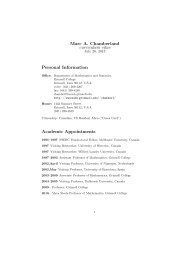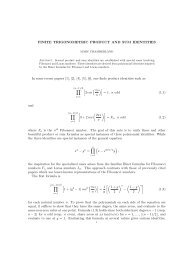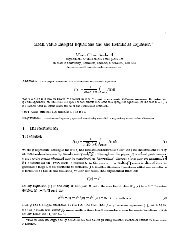An Update on the 3x+1 Problem Marc Chamberland Contents
An Update on the 3x+1 Problem Marc Chamberland Contents
An Update on the 3x+1 Problem Marc Chamberland Contents
You also want an ePaper? Increase the reach of your titles
YUMPU automatically turns print PDFs into web optimized ePapers that Google loves.
22<br />
Figure 4: Julia set of <strong>Chamberland</strong>’s map extended to <strong>the</strong> complex plane<br />
fixed point of <strong>the</strong> map f), yielding a dynamically equivalent map h defined <strong>on</strong><br />
[0, µ 1 ] as<br />
⎧<br />
⎨<br />
h(x) =<br />
⎩<br />
4x<br />
4+x−(2+x) cos(πx) , x ∈ (0, µ 1]<br />
0, x = 0<br />
.<br />
Lastly, <strong>Chamberland</strong> makes statements regarding any general extensi<strong>on</strong> of f:<br />
it must have 3-cycle, a homoclinic orbit (snap-back repeller), and a m<strong>on</strong>ot<strong>on</strong>ically<br />
increasing divergent trajectory. To illustrate how chaos figures into this<br />
extensi<strong>on</strong>, Ken M<strong>on</strong>ks replaced x with z in <strong>Chamberland</strong>’s map and numerically<br />
generated <strong>the</strong> filled-in Julia set. A porti<strong>on</strong> of <strong>the</strong> set is indicated in Figure 4.<br />
In a more recent paper, Dum<strong>on</strong>t and Reiter[28](2003) produce similar results<br />
for <strong>the</strong> real extensi<strong>on</strong><br />
f(x) := 1 2<br />
(<br />
)<br />
3 sin2 (πx/2) x + sin 2 (πx/2) .<br />
The authors have produced several o<strong>the</strong>r extensi<strong>on</strong>s, as well as figures representing<br />
stopping times; see Dum<strong>on</strong>t and Reiter[29](2001).<br />
Borovkov and Pfeifer[15](2000) also show that any c<strong>on</strong>tinuous extensi<strong>on</strong> of T<br />
has periodic orbits of every period by arguing that <strong>the</strong> map is turbulent: <strong>the</strong>re<br />
exist compact intervals A 1 and A 2 such that A 1 ∪ A 2 = f(A 1 ) ∩ f(A 2 ).





